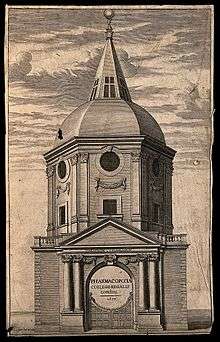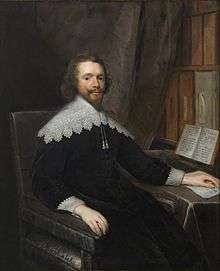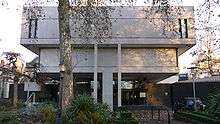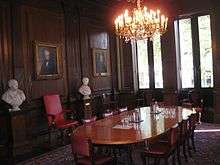Royal College of Physicians
 | |
| Established | 1518 |
|---|---|
| President | Andrew Goddard |
| Location |
London, NW1 United Kingdom |
| Members | 35,000 (2018) |
| Website |
www |
The Royal College of Physicians is a British professional body dedicated to improving the practice of medicine, chiefly through the accreditation of physicians by examination. Founded in 1518, it set the first international standard in the classification of diseases, and its library contains medical texts of great historical interest.
The college hosts four training faculties: the Faculty of Forensic and Legal Medicine, the Faculty for Pharmaceutical Medicine, the Faculty of Occupational Medicine and the Faculty of Physician Associates. The college is sometimes referred to as the Royal College of Physicians of London to differentiate it from other similarly named bodies. Its home in Regent's Park is one of the few post-war buildings to be granted Grade I listed status.
In 2016 it was announced that the North of England centre of excellence was to be based at a new building in the Liverpool Knowledge Quarter in Liverpool.[1] The new centre is set to open in 2020.[2]
History

A small group of distinguished physicians, led by the scholar, humanist and priest Thomas Linacre, petitioned King Henry VIII to be incorporated into a College similar to those found in a number of other European countries. The main functions of the college, as set down in the founding Charter, were to grant licences to those qualified to practise and to punish unqualified practitioners and those engaging in malpractice. This included apothecaries as well as physicians.
It was founded as the College of Physicians when it received a Royal Charter in 1518, affirmed by Act of Parliament in 1523. It is not known when the name "Royal College" was first assumed or granted. It came into use after the charter of 1663.[3] It was legally confirmed in 1960 by the Royal College of Physicians of London Act (which was primarily required in order to move the premises of the college outside of the Cities of London or Westminster to Regent's Park).
The college has been continuously active in improving the practice of medicine since its foundation, primarily though the accreditation of physicians. It is a member of the UK Academy of Medical Royal Colleges. It is sometimes referred to as the Royal College of Physicians of London to differentiate it from other similarly named bodies. It was the first College of Physicians in Britain or Ireland. Its establishment followed the incorporation of the Barber-Surgeons of Dublin in 1446 (by Royal Decree of Henry VI of England as Lord of Ireland), which was the first medical corporation in Ireland or Britain; the Barber-Surgeons of Edinburgh were incorporated by the City of Edinburgh in 1505.

The college was based at three sites in the City of London near St Paul's Cathedral, before moving to Pall Mall East (overlooking Trafalgar Square), and finally on to its current location in Regent's Park.
The first Harveian Librarian was Christopher Merret, a fellow of the college and a friend of Harvey. He was set up with a lifetime appointment that compensated him with room and board and a small stipend. In 1666, the Great fire of London destroyed many of the rooms and most of the books, so they tried to break the contract with Merret, but he fought them at the King's Court, claiming it was a lifetime appointment. He eventually lost the case, was expelled from the Fellowship, had to seek private lodgings and return the books he had rescued from the fire.[5] [6]
Throughout its history the college has issued advice across the whole range of medical and health matters. College publications include the first ten editions of the London Pharmacopoeia (written in Latin, and used for regulating the composition of medicines from 1618 and, through the college's police the Censors, for enforcing the college's monopoly on medical science, then being challenged by the Society of Apothecaries), and the 'Nomenclature of Diseases' in 1869. The latter created the international standard for the classification of diseases which was to last until the World Health Organisation's Manual of the international classification of diseases superseded it in the twentieth century.
The college became the licensing body for medical books in the late seventeenth century, and sought to set new standards in learning through its own system of examinations. The college's tradition of examining continues to this day and it is still perhaps how the college is best known to the general public.
The Royal College of Physicians will celebrate its 500-year anniversary in 2018.[7]
Membership and fellowship
Membership
The MRCP(UK) postnominal is used by doctors who have passed the examinations for the Diploma of Membership of the Royal Colleges of Physicians of the United Kingdom, which are held jointly by all of the UK Royal Colleges of Physicians.[8] Holders of the MRCP(UK) may also become "Collegiate Members" of the London College (using the additional post-nominal MRCP(Lond)) and/or of the other two UK colleges. Affiliate membership of the Royal College of Physicians is a similar level of membership as collegiate membership, but is awarded to senior doctors without MRCP(UK). Both Collegiate Members and Affiliate Members may be considered for advancement to fellowship of the college.
The college also has associate, medical student, and foundation doctor levels of membership.
Fellowship
Fellows of the Royal College of Physicians (who use the post-nominal FRCP)[9] are elected mostly from the general membership (collegiate or affiliate), but also occasionally from among the members of the more specialised faculties within the Royal Colleges of Physicians, e.g. Occupational Medicine (MFOM), Pharmaceutical Medicine (MFPM), and Forensic and Legal Medicine (MFLM), etc. There are also fellows who are elected de jure (usually medical experts from other countries) and honoris causa (dignitaries, members of the Royal Family, etc.).[10]
Licentiate
The diploma of Licentiate of the Royal College of Physicians (LRCP) is no longer awarded. The LRCP qualification used to be reserved for medical graduates, in practice mainly Bachelors of Medicine from Oxford and Cambridge, but in the mid-nineteenth century became part of a very popular initial qualification in medicine awarded together with the MRCS (Eng) by the Conjoint Board, which by the end of the twentieth century came to be largely taken by overseas graduates. From 1993 the LRCP was awarded together with the LRCS and LMSSA through the United Examining Board until this pathway to medical registration was abolished in 1999.
Library
The library aims to support the learning and information needs of the RCP's members, students, and staff. The unique collections are also used by members of the public interested in researching. The enquiry service provides information on the current role and functions of the RCP as well as its history.[11]
- history of medicine
- genealogy
- health and social policy
- medical education
Rare book collections
The Royal College of Physicians has had a library since its foundation in 1518, although most of the original books were destroyed during the Great Fire of London in 1666. The rare books and special collections are diverse in coverage, reflecting the collecting habits of earlier fellows and the need to provide the broad educational base considered suitable for physicians.[12]
Books and journals — new and old — display a continuum of change and development in the RCP's specialties, as well as in the medical profession. Highlights include:
- approximately 130 books printed before 1502, including some of the earliest printings of the classical medical texts by Greek, Roman and Arabic doctors
- books belonging to and annotated by the Elizabethan astrologer and occultist John Dee
- approximately 3,000 books, dated up to 1688, in the Dorchester collection, on a variety of subjects including architecture, science and travel
- over 4,500 tracts from the 17th to the 19th century covering a wide range of subjects, both medical and scientific
- the Evan Bedford collection, which includes almost every significant text in the history of cardiology up to 1970
Highlights of the 20th century collection include:
- books relating to the history of the RCP's specialties
- biographies of fellows and prominent figures in medicine
- books relating to the formation of the National Health Service (NHS) and its continuing history
- books relating to the history of hospitals in the UK
- books relating to medical ethics and the status and role of the physician
- every item published by the RCP, including reports and pamphlets.
The book collections are displayed in regularly changing exhibitions.
Museum collections

The collections at the Royal College of Physicians relate to the history of the college, and the history of the Physician's profession. They help to place the history and development of medicine and health care in its widest context. The collections include: portraits, silver, medical instruments, the Symons Collection, commemorative medals and anatomical tables.
The collection of c. 250 portraits provides a pictorial and sculptural record of presidents, Fellows and other physicians associated with it from its foundation in 1518 to the present day. It includes pieces by well-known artists, such as a bust of Baldwin Hamey Junior (1600–1676) by Edward Pierce and one of Richard Mead (1673–1754) by Louis François Roubiliac. There are portraits, such as Richard Hale (1670–1728) by Jonathan Richardson. In 1964 a volume on the Portraits of the college was published by Gordon Wolstenholme in which they were described by David Piper.
The silver collection has few pieces pre-dating the Great Fire of London (1666) because of a robbery during the previous year. Baldwin Hamey's inkstand bell and William Harvey's whalebone demonstration rod, tipped with silver, are two that survive.[13] Many pieces of silver are used to this day for formal occasions in the college. Special objects include the President's staff of office, the caduceus and the silver-gilt College mace.
The college also owns six 17th-century anatomical tables, probably made by drying and mounting the actual blood vessels and nerves of the human body onto blocks of wood and then varnishing them. They would have been used as a teaching aid for teaching anatomy, because it was difficult to obtain cadavers for dissection.
The Symons Collection of medical instruments is displayed within the college building. It began as a collection of objects relating to self-care in Georgian times and expanded to include items that would have been used by physicians when treating patients, mostly in the eighteenth and nineteenth centuries.
The collections are open to the general public Monday to Friday 9 am – 5 pm. The Royal College of Physicians is a member of the London Museums of Health & Medicine.[14]
Facility

The college is located in St. Andrews Place, which is at the north end of the road running up the east side of Regent's Park, Park Square East. The college's previous headquarters, on Pall Mall East/Trafalgar Square, is now Canada House, part of the Canadian high commission in London. The college had a number of other locations prior to Pall Mall East, in the City of London.

The current College building itself is notable. It was designed by architect Sir Denys Lasdun, opening in 1964 and has since been recognised as a building of national importance: it is a Grade I listed building, one of a very select band of post-war buildings sharing this distinction.[15] Lasdun's use of mosaic clad concrete was extremely influential on many later public buildings. An interesting feature of the building was a 'Moving Wall', weighing five tons (5080 kg) and capable of being hydraulically lifted ten feet (3050 mm) to unite or sub-divide a hall of sixty-two feet (18.9 m) width, which was the interior width of the building. The hydraulic equipment and the steel framework for the Moving Wall were produced by Merryweather & Sons Ltd of Greenwich, hydraulic engineers. Although better known for fire fighting equipment it was not the company's first installation of this kind.[16]
Publications
Clinical Medicine is the college's own medical journal. It appears once every two months. In addition, the college publishes regular reports, clinical guidelines, and the annual series 'Horizons in Medicine'. The Faculty of Occupational Medicine publishes Occupational and Environmental Medicine, a monthly-published journal that contains studies and articles concerting topics related to human health and environmental topics.
Faculties
The Royal College of Physicians hosts four training faculties: the Faculty of Forensic and Legal Medicine, the Faculty for Pharmaceutical Medicine, the Faculty of Occupational Medicine and the Faculty of Physician Associates.
Pharmaceutical Medicine
The Faculty of Pharmaceutical Medicine (FPM) of the Royal Colleges of Physicians aims to maintain the highest professional standards in the speciality through activities such as the setting of the Diploma in Pharmaceutical Medicine and other examinations and supervising speciality training in pharmaceutical medicine.[17]
Occupational Medicine
The Faculty of Occupational Medicine was established to develop and maintain high standards of training and professional integrity in the speciality of occupational medicine. It sets exams, supervises training and supports physicians in their continued professional development. The Faculty also acts as an authoritative body for consultation in matters of education and public interest concerning occupational medicine.[18]
Physician Associates
The Faculty of Physician Associates was established in June 2015 to take on the role previously held by the former membership body; the UK Association of Physician Associates (UKAPA).[19][20] The faculty governs the training for physician associates and oversee the managed voluntary register.[21]
College lectures
The college holds an annual lecture, commonly referred to as the Lumleian Lectures, which were named in honour of Lord Lumley and established as part of the Lumleian Trust. The trust and lectures were established in 1582 by Richard Caldwell, a former president of the college.[22] The subject matter of the lectures was initially in surgery, which was later changed to in medicine.[23] The first lecture was given by Richard Forster, and the lectures continue to today.
Other annual lectures are the Croonian Lecture, the Goulstonian Lecture, the Bradshaw Lecture and the Milroy Lectures.
Once a year, traditionally on St Lukes Day, a Fellow is appointed to deliver the Harveian Oration to the assembled college in memory of William Harvey. The oration seeks to honour the founders and benefactors of the college and encourage a spirit of experimentation amongst the members.
Awards
The Bisset Hawkins Medal is a triennial award founded in 1899 in honour of Francis Bisset Hawkins, a fellow of the college, to recognise work done in the preceding ten years in advancing sanitary science or promoting public health.[24] The Baly Medal is a biennial award, founded by a gift from Frederick Daniel Dyster (1809?–93) received in 1866, confirmed by deed 1930 – in memory of William Baly: £400 to provide a gold medal for the person deemed to have most distinguished himself in the science of physiology, especially during the previous two years.
See also
References
- ↑ Murphy, Liam (29 July 2016). "Liverpool secures new Royal College of Physicians northern headquarters". liverpoolecho.co.uk. Retrieved 27 March 2018.
- ↑ "MIPIM: £35m Royal College of Physicians HQ in Liverpool will be one of the UK's healthiest buildings - Liverpool Business News". Liverpool Business News. 14 March 2018. Retrieved 15 March 2018.
- ↑ Davenport, Geoffrey; McDonald, Ian; Moss-Gibbons, Caroline (2001). The Royal College of Physicians and Its Collections: An Illustrated History. Royal College of Physicians. p. 26. ISBN 9780907383833. Retrieved 12 July 2017.
- ↑ "Architecture and buildings :Warwick Lane 1675-1825". Royal College of Physicians. Archived from the original on 26 December 2012. Retrieved 1 February 2015.
- ↑ Munk, William. "Christopher Merrett". Royal Society of Physicians, Lives of the Fellows, Volume I. p. 258.
- ↑ Dodds 1954.
- ↑ "Innovation in Medicine 2018: RCP annual conference". RCP London. 27 April 2017. Retrieved 9 February 2018.
- ↑ "About us | MRCPUK". www.mrcpuk.org. Retrieved 2016-01-02.
- ↑ Anon (2016). "Fellowship of the RCP". rcplondon.ac.uk. London: Royal College of Physicians. Archived from the original on 2016-06-15.
- ↑ "Fellowship of the RCP". RCP London. Archived from the original on 15 June 2016. Retrieved 2 January 2016.
- ↑ "Library". RCP London. Retrieved 2016-01-02.
- ↑ "Archive and historical library collections". RCP London. Retrieved 2016-01-02.
- ↑ Munk, William. "William Harvey". Royal Society of Physicians, Lives of the Fellows, Volume I. p. 124.
- ↑ "Medical Museums". medicalmuseums.org. Retrieved 26 August 2016.
- ↑ "RCP architecture and buildings". Royal College of Physicians. Retrieved 11 December 2015.
- ↑ Technical details of the Moving Wall can be found in Engineering Journal, 1 January 1965.
- ↑ "Training and development (pharmaceutical medicine)". www.healthcareers.nhs.uk. Health Education England. Retrieved 12 December 2015.
- ↑ "Spotlight on Royal Colleges: Faculty of Occupational Medicine". www.medicalcareers.nhs.uk. Retrieved 18 February 2015.
- ↑ "New Faculty of Physician Associates launched today" (Press release). Royal College of Physicians. 2 July 2015. Retrieved 3 July 2015.
- ↑ "Joint statement on the announcement of more physician associates" (Press release). Royal College of Physicians. 22 August 2014. Retrieved 3 July 2015.
- ↑ "PAMVR | Faculty of Physician Associates - quality health care across the NHS". www.fparcp.co.uk. Retrieved 2017-12-01.
- ↑ "Richard Caldwell". Munks Roll.
- ↑ "Heritage Centre : College Lectures". Royal College of Physicians. Retrieved 3 August 2008.
- ↑ Farewell V, Johnson T (2010). "Woods and Russell, Hill, and the emergence of medical statistics". Stat Med. 29: 1459–76. doi:10.1002/sim.3893. PMC 2991772. PMID 20535761.
Further reading
- Dodds, C. (December 1954). "Christopher Merrett, F.R.C.P. (1614–1695), First Harveian Librarian". Proceedings of the Royal Society of Medicine. 47 (12): 1053–1056. PMC 1919154. PMID 13237193.
External links
- Official website

- MRCP(UK) website
- Faculty of Physician Associates at the RCP
- Notes on the Royal College of Physicians from the Scholarly Societies project (includes information on the journals of the society)
Coordinates: 51°31′32.83″N 00°08′41.89″W / 51.5257861°N 0.1449694°W